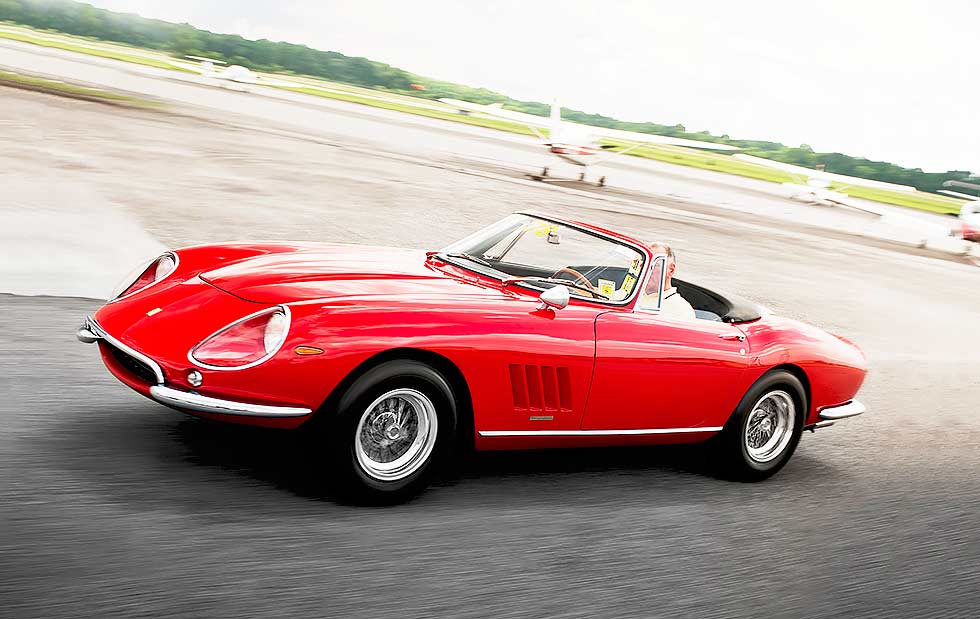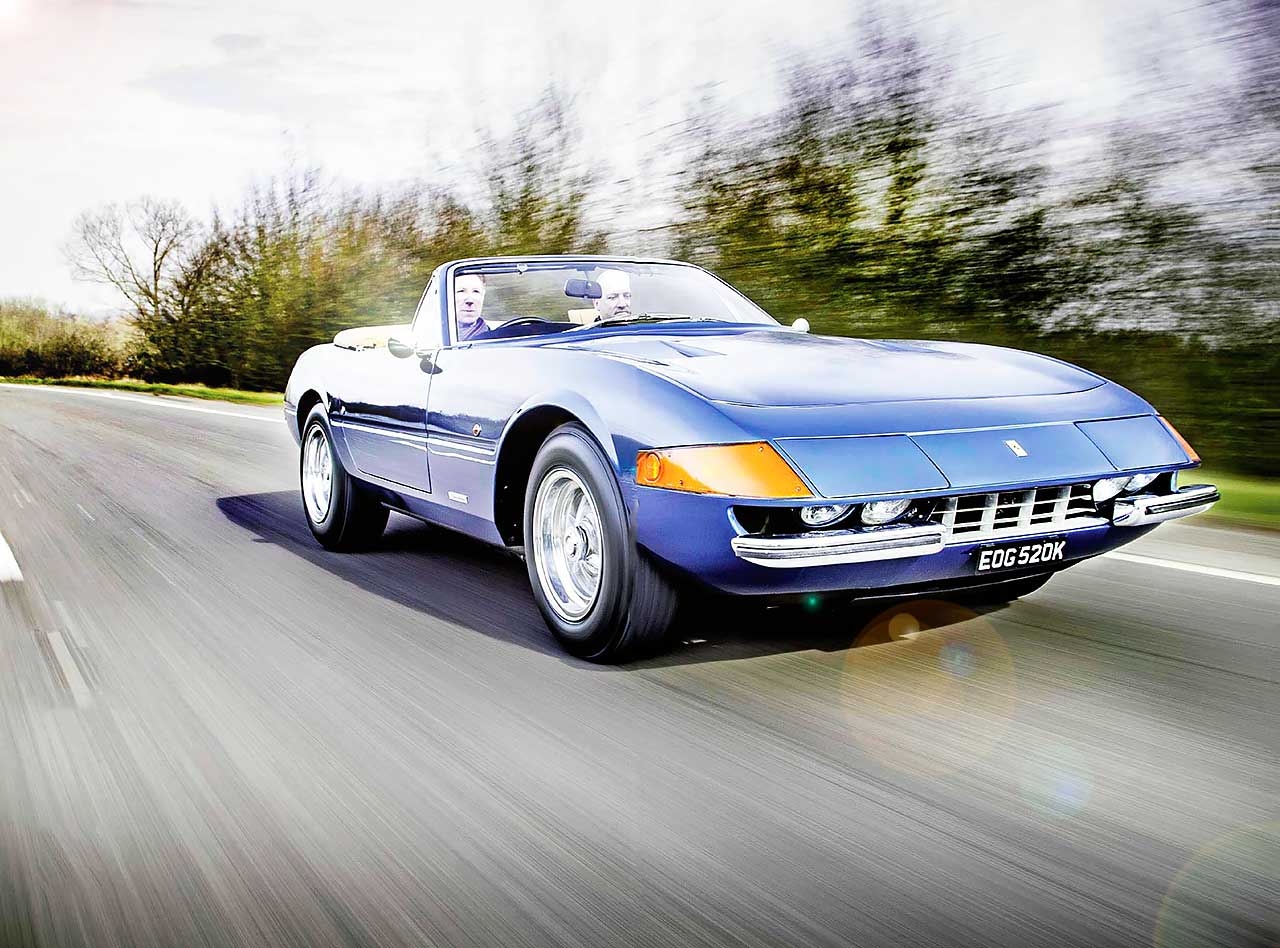
‘You just can’t buy a better piece of art’ Andrew Martin has lusted over the Ferrari Daytona since he was a lad. We put him behind the wheel of a Spider conversion to discover if the V12 reality matches his dream. Words Ross Alkureishi. Photography Charlie Magee.
We give one lucky reader the drive of a lifetime in a Ferrari Daytona Spider. COVER The List We put reader and former TVR owner Andrew Martin into a Ferrari Daytona Spider conversion – does the once-in-a-lifetime top-down blast live up to the V12 dream? Ferrari Daytona one reader 352bhp. “Heaven!”
‘You know exactly what the car’s going to do and it rides the road perfectly – I can’t fault it’
For me all the Ferrari numbers and designations were confusing as a youngster and they still are, to be honest,’ says Andrew Martin. Back then he coveted two Ferraris – the Dino, brought to him in left-hand-drive form by Tony Curtis via TV show The Persuaders, and the Daytona. ‘I tried ever so hard to get my father to buy the then-new Rover SD1 3500 just to have the Daytona-inspired wraparound indicators,’ he remembers. ‘But even this connection evaded me because he went and bought a Triumph.’
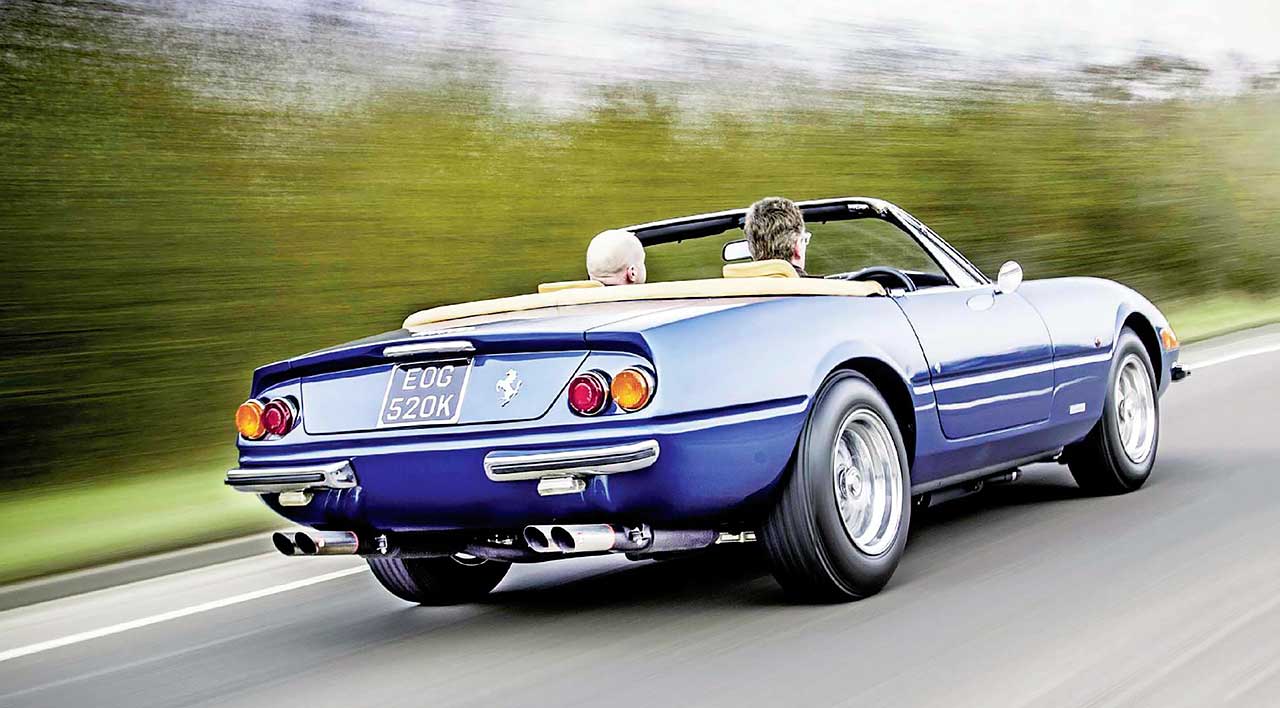
Today it’s no mass-produced supercar substitute that we’re here to drive – it’s the real deal and Andrew’s growing excitement at the prospect of its arrival is palpable. ‘Gosh, how I loved every detail of that car – the V12 engine, the interior with those seats that looked so comfy, the rear lights that were works of art in themselves, the exhausts poking out menacingly, the H-gate gearshift, the pop-up lights, and those indicators…’
His reverie is broken, first by the din of 12 cylinders firing belligerently to life and then by the sight of the object of his lifelong passion edging out into the courtyard. Behind the wheel is Spencer Herbert, sales manager at Kent-Based Ferrari specialist Barkaways, where the car is for sale. This 1972 Daytona has covered just 8045 miles from new and was originally a UK car that found its first owner in Australia. He sent it to California where Ferrari converter Richard Straman transformed it from a Berlinetta to a Spider.
‘It’s the best, isn’t it?’ says Andrew. It’s a statement, not a question. ‘In that hue, the shimmer of the blue against that tan leather interior, I think you just can’t buy a better piece of art.’ I can only agree with him; the Blue Dino Metallizzato paint and contrasting interior look glorious and, personally, I can’t think of a more gratifying form of art than a classic car.
‘You’ve driven a Ferrari before?’ asks Spencer. ‘Er, no,’ replies Andrew. The car’s owner has asked Spencer to accompany Andrew initially and as they settle into the luxuriously trimmed cabin Andrew attempts to redeem himself by demonstrating some Ferrari knowledge. ‘So, it’s first to third gear from cold?’ he asks. ‘Usually,’ his chaperone replies as they gently thrum away. ‘But it’s just had a new clutch and is well prepared so you should be okay.’
They return half an hour later. First impressions, Andrew? ‘It’s blinking cold with the hood down,’ he replies. ‘But do you know what? I’ve met my hero and we’re getting on well.’ Spencer says he’s happy with how his new protégé has been handling the car, so I replace him in the passenger seat and we’re off. Open roads, blue sky, drop-top Daytona and a full tank of petrol – life surely can’t get much better than this.
‘I thought it would be a highly strung supercar,’ says Andrew. ‘But it’s really forgiving if you treat it well but firmly.’
He manoeuvres the elegant elongated snout out on to a dual carriageway and squeezes the throttle. The rear squats and massive reserves of power barrel us forward, accompanied by a sensational soundtrack as the low-speed mechanical chunterings are swallowed whole by the six carburettors’ wild intake blare and a four-pipe symphony emitted from behind us.
‘On the way up, change slowly and purposefully,’ says Andrew, repeating his newly learned gearbox mantra. ‘And then lay down the power.’ As he does so the smile spreads further across his face. Each gear sounds better than the last, with their respective crescendos interrupted only by the purposeful clacking of the gearlever on its metal gate.
‘Beyond 4500rpm that soundtrack from behind sings better than any Brits winner,’ roars my driver. Approaching a roundabout, Andrew double-declutches down through the ratios and takes it in third. ‘You can pootle round as if you’re in a Fiat Panda then squeeze the throttle and, whoosh, you’re off down the road.’
With the long expanse of dual carriageway soon devoured we hit an A-road and settle into a relaxing cruise. ‘It’s so beautifully set up, an absolute delight,’ reports Andrew. ‘The steering wheel is very big – you can’t just flick it, you turn it like a truck. But you know exactly what the car’s going to do and it rides the road perfectly. It’s great to be in – I can’t fault it.’
We turn off the main road and enter a twisting world of narrow Kentish lanes. The Daytona’s a wide car, but Andrew handles them with aplomb before parking up for a spot of lunch. This gives us time to take in the fine detail. We both marvel at the car’s mix of muscular traits and subtle design cues, such as the sculpted door pulls and handles. Contrast these with the almost commercial-sized alloy radiator and steel-reinforced pipes under the bonnet. ‘I love the toggle switch for the hazard lights – no warning triangle here,’ says Andrew. ‘And those big gauges in front of you. It really is a combination of masculinity and feminine delicacy.’
‘What’s this?’ I ask, pointing to a switch below the dashboard. ‘It’s got a power-steering upgrade fitted,’ explains Andrew. ‘That caught me out at the first turn.’
Time for me to get behind the wheel. The cabin is fabulous – simple in content but exquisite in finish. Andrew’s right about the Nardi wheel – it’s huge but quintessentially of the period. Losing the Berlinetta’s roof improves rear vision dramatically.
As I pull away the power steering catches me out, making excessive inputs too early. It feels more like the effete mechanism of a Rolls-Royce Silver Shadow, so I flick it off and the reassuringly heavy feel of steering machismo courses through my hands. That’s more like it, and it’s an integral part of the Daytona’s reputation for giving its driver a workout.
It’s exactly the same with the gearchange, which is just as uncompromising as Il Commendatore Enzo Ferrari himself. It’s thoroughly warmed through by now, so there’s no need to doubledeclutch on the way down. But Andrew’s description – via Spencer – that it needs slow deliberate engagements, is spot-on. That said, it is possible to find a rhythm that combines a firm hand with a balanced introduction of power for a relatively speedier shift – it just takes practice. And any obstinacy doesn’t really impair the Daytona’s acceleration because after each brief pause it continues to devour straight lines.
There’s not as much low-down torque as its arch-rival, the V8-powered Maserati Ghibli SS, but the Ferrari’s V12 revs around 2500rpm higher and feels more visceral. That feeling is backed up in its performance and further enhanced aurally by the additional cylinders. Americans like to say ‘there ain’t no substitute for cubic inches’ but the tifosi know it’s the extra pots that truly stir the soul. Throw in the liberation of this car’s quad Ansa tailpipes and it’s a truly delicious and addictive combination.
The Daytona feels nicely balanced, with the rear transaxle providing an adequate weight offset to the big V12 up front. It’s the consummate GT but the biggest surprise is the absolute lack of scuttle shake, even under the heaviest of loads. I had wondered how a non-factory conversion would acquit itself, but now I can see why Straman Spiders are so well regarded.
Pulling up outside Barkaways I park the Daytona where it started the day, but Spencer comes out and gestures for me to bring it inside. There’s lots of noise as I struggle to manoeuvre at low speed.
Andrew laughs until I give in, reaching under the dash for the power steering switch. Oh well, we all need to get in touch with our feminine side occasionally. So what’s Andrew’s verdict? ‘Filling out the insurance paperwork this morning for a value of £750k was a sobering experience, but it’s a testament to the car that by the afternoon I’d forgotten about it,’ he says. ‘Apparently if I hadn’t driven it properly on the initial test-drive I wasn’t going further than the bypass roundabout. Fair enough, because you don’t want to hear it screaming as some bozo lets the clutch up.’
He pauses to think before summing up. ‘I’ve driven my first Ferrari and I’m delighted to get it back intact. But the worst thing happened – I would have loved to go home and say it’s a pile of dog-doo, but that’s not the case.
‘Yes, it’s a wide car to hustle through the back roads of Kent, but it can do it. You can diddle around in traffic and there’s no complaint. But get it out on to the open road and, oh Lord. So if I had space in my garage and needed space in my wallet this is definitely a car I could take to St Tropez, the local church or Tesco.’
Thanks to: Barkaways (barkaways.com, 01622 872100), Spencer Herbert, owner Adrian Marshall.
Tech and photo
TECHNICAL DATA FILE SPECIFICATIONS 1972 Ferrari GTB/4 Daytona Spyder by Straman
Engine 4390cc V12, qohc, six Weber 40DCNF carburetors
Power and torque 352bhp @ 7500rpm; 318lb ft @ 5500rpm (DIN)
Transmission Five-speed transaxle, rear-wheel drive
Suspension Front and rear: independent, wishbones, coil springs, telescopic dampers
Steering Worm and nut
Brakes Vented discs front and rear, servo-assisted
Weight 1600kg (3527lb)
Performance 0-60mph: 5.4sec; top speed: 174mph
Fuel consumption 14mpg
Cost new £9992 (1972 Berlinetta)
Values now £600,000-£750,000
‘Filling out the insurance for a value of £750k was sobering. It’s testament to the car that by the afternoon I’d forgotten it’

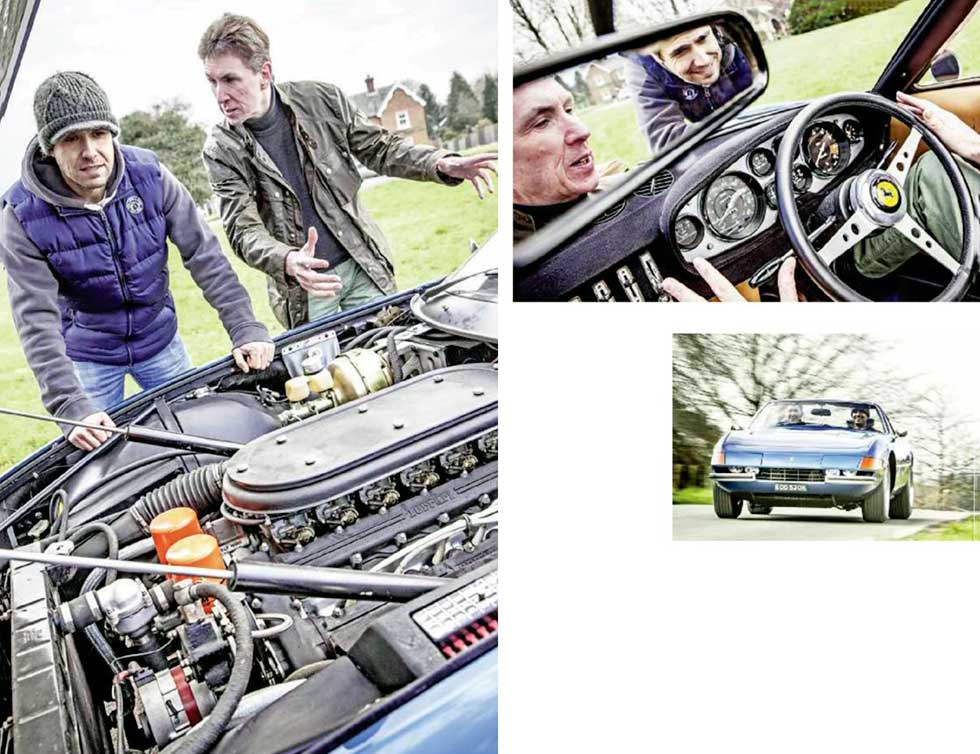
ANDREW MARTIN
Andrew is director of the Scottish Centre of Tourism at Robert Gordon University, Aberdeen. His previous classics include a Triumph Dolomite Sprint, a Triumph Stag (‘engine out twice’), a TVR S1 (‘it made the Stag look reliable’) and an orange with black velour Fiat 131 Sport.
HIS WISHLIST
Jensen Interceptor
Ferrari Daytona
Fiat 130 Coupé
Panther De Ville
Alfa Romeo Montreal
Lotus Elan +2 130S
Morgan Plus 8
Sunbeam Tiger
Honda NSX (first generation)
Mercedes-Benz E500 W124
THE EVOLUTION
1968 DAYTONA GTB/4
The 275GTB replacement is launched at 1968’s Paris Salon. It has the same chassis and engine as its quad-cam predecessor, with the latter now enlarged to 4.4 litres, a five-speed transaxle and all-round independent suspension. Its 352bhp at 7200rpm is good for 0-60mph in 5.3sec and a top speed of 174mph, making it the world’s fastest production car. The press coin the Daytona name to mark Ferrari’s 1-2-3 finish in the 1967 Daytona 24-hour race. A front-end restyle in 1971 sees popup headlamps replace the Plexiglas-covered lights because of tighter US crash regulations.
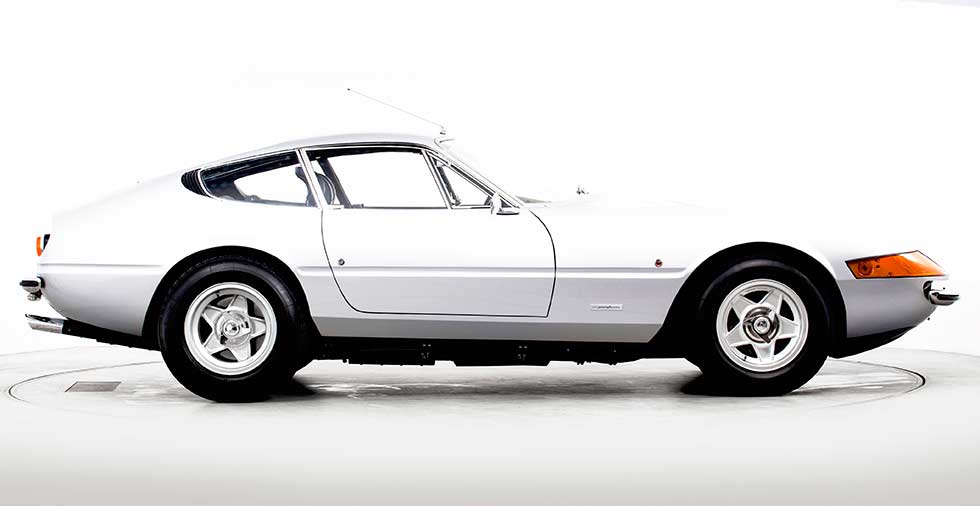
1971 DAYTONA GTS/4
The prototype convertible is displayed at the 1969 Frankfurt Motor Show with Plexiglas front lights, but when the production car arrives in 1971 these have been replaced by the Berlinetta’s pop-ups. Scaglietti constructs just 122 drop-tops including seven right-hand-drive examples. Fully orange indicator lenses replace the earlier contrasting units, and steel replaced the earlier alloy doors.
A popular move is to chop the top off a Coupé to make a Spider; the most respected producer of these cars was California-based Richard Straman.

1971 DAYTONA COMPETIZIONE
Fifteen race-prepped specials for privateer racers are built in three batches of five. All have handcrafted alloy and glassfibre bodies, with Plexiglas replacing the standard windows. The first batch have a standard 352bhp motor but subsequent cars add about 50bhp per year. Competiziones take class victories at Le Mans between 1972 and ’1974 and actor and racer Paul Newman, driving with Milt Minter and Elliot Forbes-Robinson, score a fifth overall finish in 1977. Daytona production ends in 1974 with around 1400 built.
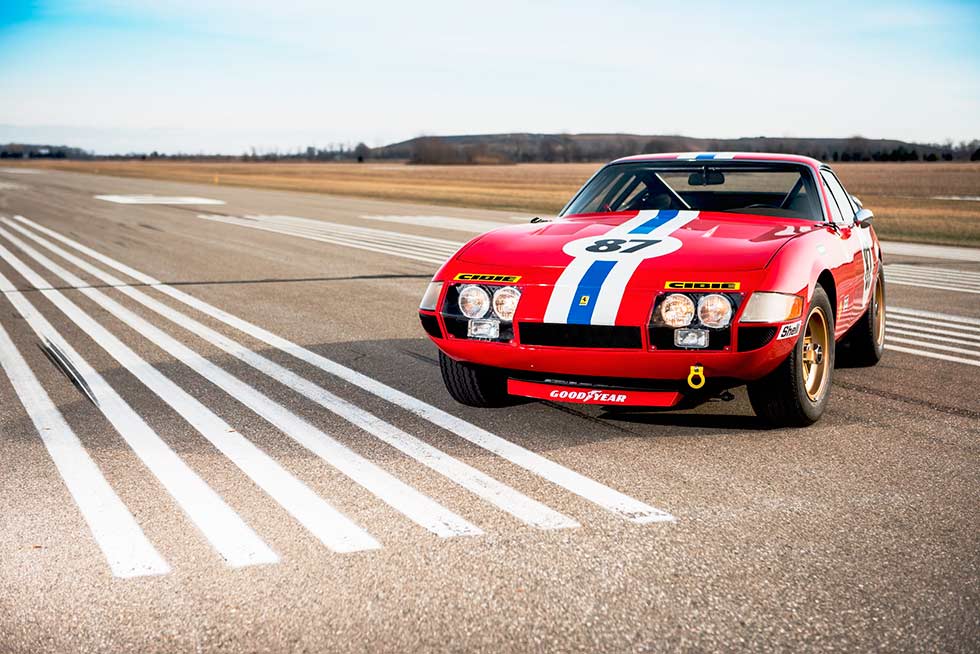
CHOP-TOP FERRARIS
FERRARIS ON THE CHOP When scarcity fuelled a burgeoning conversion market.
With demand for Spider versions of Ferraris outstripping supply, young Californian coachbuilder and engineer Richard Straman first turned a Ferrari 275 GTB/4 Berlinetta into a convertible in the early Seventies. Such was the quality of his work that his career path was set.
He was helped by a price frenzy in the late Seventies that saw a Spider worth three times the value of a Berlinetta. Inevitably others joined the gold rush. There were four main players – Autocraft in the UK (completed 10 cars), Auto Sport in Modena (around 25), European Auto Restoration in California (around 28). Richard Straman Company converted around 35.
Conversions varied from simply removing the roof to completely remanufacturing the sub-frame and wheelarches. Genuine Spiders had a glassfibre bulkhead reinforced with steel, extra bracing between front footwells and firewall, and through rocker sill panels, steel inner and outer wheelarches. This was very expensive to replicate, so conversions vary wildly as to how far they went in doing so.
Today the Straman cars are most highly regarded. ‘If it’s a Daytona conversion you’re after, then they’re very desirable,’ says Barkaways’ Spencer Herbert. ‘Where possible Straman used original Ferrari parts and the details and lines and shape of the car are very close to the original. The wheelarches at the rear are very convincing and the hood on this particular car has been produced to an extremely high level, with no water ingress and minimal wind noise.’
Original factory Spiders also had steel inner wheelarches and a reinforced bulkhead instead of the Berlinetta’s glassfibre bulkhead and inner/outer wheelarches, as well as extra bracing for improved rigidity. ‘A Straman car doesn’t have the steel inner wheelarches but is engineered in a way that ensures a complete lack of scuttle shake – to drive one is to be impressed,’ says Spencer.
‘They list in desirability as Spiders, Berlinettas and then conversions,’ explains Spencer. ‘The current market favours original cars, but if you want a conversion then the Straman is the one to have. And there really isn’t another open-topped, V12 Ferrari from that classic era that you can buy for less than £1.5 million today.’
These days, original Spiders are £2m+, Berlinettas are £575k-£850k and conversions are £600k-£750k. Daytona conversions aren’t valid for a Classiche certificate but Spencer believes they continue to be ‘very, very attractive in terms of value’.
Straman remains best known for his Daytona Spiders but he also produced convertible conversions of a number of different marques including Mercedes-Benz, Bentley and Nissan. He continued removing the tops from Prancing Horses and produced some excellent Ferrari BB and Testarossa conversions.
“These isn’t another open-topped, front-engined V12 classic Ferrari for less than £1.5 million today”
